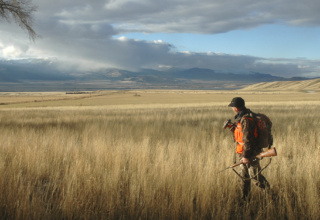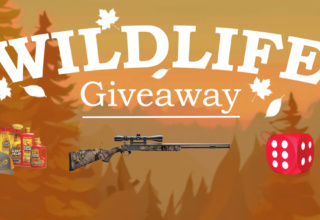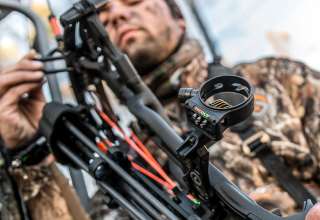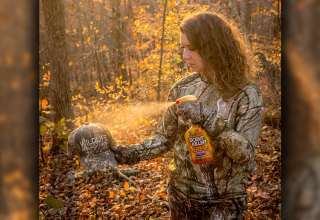Deer have their own minds, but you can manipulate them to your advantage with these easy tips
by Tracy Breen
Most deer hunters have hunted over a scrape at some point during their hunting career. Some hunters prefer to hunt over a real scrape made by a buck or doe. Other hunters prefer to make mock scrapes. Dedicated deer hunters often build and hunt over scrapes during the pre-rut or during the peak of the rut, but many diehard scrape hunters prefer to start scrapes long before deer season even begins.
Start Early
Outdoor writer Steve Bartylla is one guy who starts early.
“I like to build mock scrapes late in the summer and early fall so I can get deer accustomed to using the scrapes long before the rut,” Bartylla said. “Freshening up real scrapes that deer make in the same areas every year and building mock scrapes early is a great way to take a buck inventory before the rut.
“I like to build scrapes in areas that bucks traditionally build scrapes. One of my favorite places to put a scrape or do a scent drag is on the downwind side of a doe bedding area. Bucks like to cruise through these areas looking for hot does in the rut. By building these scrapes early in the season, the bucks and the doe will start hitting the scrapes early and using them. When season arrives, my stands will be placed nearby, and I will be ready. When the bucks coming cruising through in the rut, they will walk right by my stand.”
Choose Your Location Wisely
When choosing scrape locations, Bartylla always puts scrapes where deer want to be. He builds them in such a way that he can get to a stand nearby without disturbing the scrape as he approaches.
“One mistake many hunters make is building scrapes near the path they walk to as they approach their stand. All it takes is a little human odor in or near a scrape to spook deer. I like approaching my stand from a certain direction where the wind is right for the location and having my scrape near the stand, but in an area that is completely undisturbed by me when I walk into my stand. Many hunters think that a mock scrape spooks deer. The truth is, in most cases, big bucks are spooked by scrapes because they smell human odor.”
Use a Magnum Scrape-Dripper
Many scrapes are no longer used by deer because the scrape is visited too often by the hunter. Hunters love to freshen up their scrapes and check trail cameras near the scrapes, but that can greatly increase the odds of human odor being left behind, said Bartylla. “I prefer to use a Wildlife Research Center Magnum Scrape-Dripper over my scrapes so I don’t have to visit the scrapes very often. The dripper keeps the scrape fresh.”
Use the Proper Scent
A Magnum Scrape Dripper only dispenses scent during daylight hours. Four ounces of scent will last several weeks. During the early season, it is best to use a scent that is not super strong. A couple great options are Wildlife Research Center’s synthetic Buck Nip or Golden Scrape. Buck Nip is a curiosity scent that will attract deer, but it does not contain estrus or strong urine that may spook deer early in the season. Golden Scrape is a formula that contains buck and doe urine as well as fresh scraped earth odors. This combination of scents brings bucks and doe to the scrape. Instead of just being a territorial buck scrape, it can turn any mock scrape into a community scrape.
Using Estrus Scent
When the rut is right around the corner, Special Golden Estrus is a great estrus urine to use in a dripper to attract bucks to the scrape.
“Timing is everything,” says Bartylla. “In the early season, you want deer to get used to coming to a scrape. When the rut kicks in, you switch scents which can drive bucks crazy. The goal is to make coming to the scrape part of the daily routine for bucks and doe. By properly placing a scrape near where the deer want to be, I am basically setting a trap. They are comfortable coming to the area, they hit the scrape repeatedly without any human odor problems, and when the rut is on, I can go in, hunt the area, and hopefully kill a nice buck near the scrape.”
Add a Licking Branch
Most natural scrapes made by deer are built under a low-hanging branch. The low-hanging branch becomes a licking branch that is used by deer to communicate with one another. When building mock scrapes or when taking over a real scrape, use a licking branch. If you are building a scrape near a tree that doesn’t have a licking branch, Bartylla suggests adding one.
“A hunter can wire a limb to a cedar post and make their own tree and licking branch combo or wire a limb to a tree over the top of their scrape. Either way, it is important to always have a licking branch. Deer like to communicate with one another via a licking branch, and it really draws in bucks.”
Build a Scrape Line
Creating a complete scrape line near a doe bedding area is another way to make scrapes more realistic. Bucks will often create scrape lines near their core area. By doing this yourself, you can greatly increase the odds of a buck checking out the area during daylight hours during season. Building multiple scrapes near a bedding area can help entice Mr. Big out of his bedroom during daylight.
Build a Trap
Many hunters believe that scrapes are only to be hunted over during the rut, which is not the case. Deer will often use community scrapes all year and bucks often build more scrapes near community scrapes and bedding areas in early fall. They frequent them more as the rut approaches. By building scrapes early near areas bucks want to be, hunters can create a trap for the buck.
When building scrapes, make sure you are building them where deer want to be, make sure the scrape is near trees where a stand can be hung, and where the wind will be right for that hunting location. Mock scrapes allow you to be an architect and builder. If you build in the right location, your odds of filling a tag greatly increase.
Deer will frequent scrapes during the early season, the rut, and the late season. Building and hunting over scrapes throughout the hunting season is a great option for all deer hunters. As the saying goes, the early bird gets the worm. Build your scrapes early in the season or before. Once season opens and the bucks start hitting your scrapes regularly, climb in your tree stand a hunt. The trap is now set.
- Single- vs Multi-Pin Sights - October 29, 2020
- Cash in on Early-Season Scrapes - September 21, 2020
- Scent Elimination Strategies EVERY Hunter Needs to Know - September 2, 2020






















